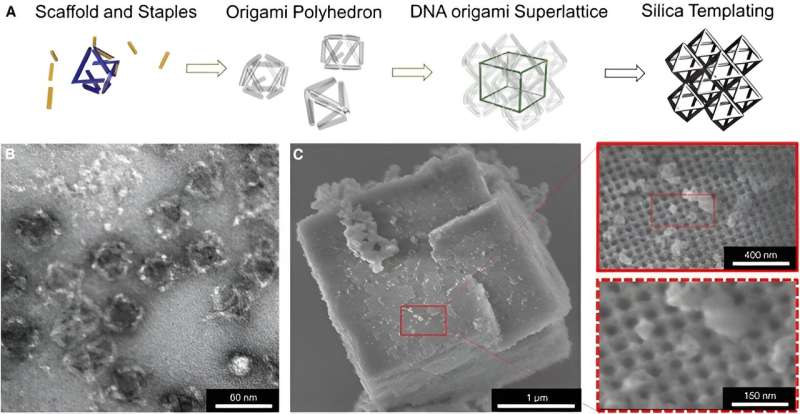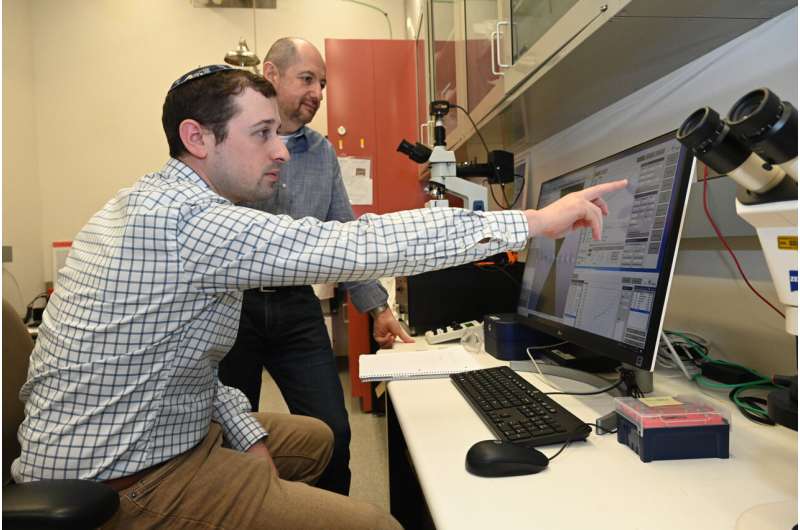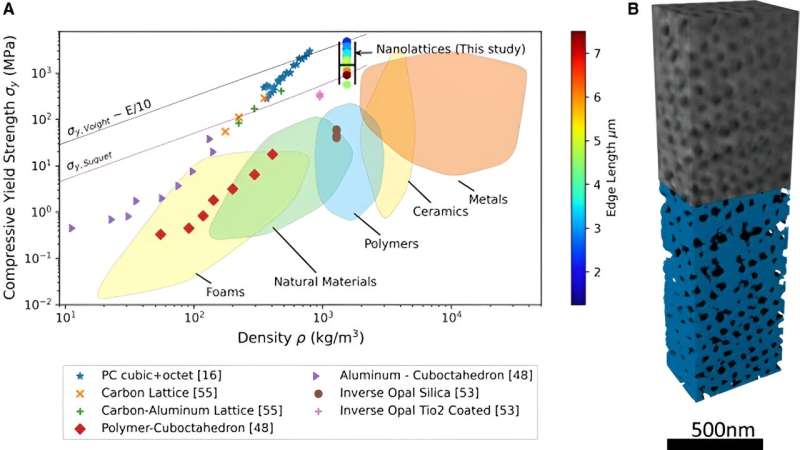This article has been reviewed according to Science X's editorial process and policies. Editors have highlighted the following attributes while ensuring the content's credibility:
fact-checked
peer-reviewed publication
trusted source
proofread
Researchers create a lightweight, high-strength material using two unlikely ingredients: DNA and glass

Working on the nanoscale gives researchers a lot of insight and control when fabricating and characterizing materials. In larger scale manufacturing, as well as in nature, many materials have the capacity for flaws and impurities that can disrupt their complex structure. This creates several weak points that can easily break under stress. This is common with most glass, which is why it is thought of as such a delicate material.
Scientists at the Columbia University, University of Connecticut, and the U.S. Department of Energy's (DOE) Brookhaven National Laboratory were able to fabricate a pure form of glass and coat specialized pieces of DNA with it to create a material that was not only stronger than steel, but incredibly lightweight. Materials that possess both of these qualities are uncommon, and further research could lead to novel engineering and defense applications. The results were published in Cell Reports Physical Science.
DNA: The building blocks for life and more
In living things, deoxyribonucleic acid, more commonly known as DNA, carries biological information that instructs the cells of organisms on how to form, grow, and reproduce. The material DNA is made of is known as a polymer, a class of tough, elastic materials that includes plastic and rubber. Their resilience and simplicity have intrigued material scientists and inspired many interesting experiments.
Oleg Gang, a materials scientist at the Center for Functional Nanomaterials (CFN), a DOE Office of Science User Facility at Brookhaven Lab, and a professor at Columbia University, has been leveraging DNA's unique properties for materials synthesis for years, resulting in numerous discoveries. This novel technology has inspired an array of innovative applications—from drug delivery to electronics.
Gang had previously worked with the paper's lead author, Brookhaven postdoctoral researcher Aaron Michelson, on an experiment using DNA structures to build a robust framework for novel materials.
DNA molecules behave in an interesting way. The individual nucleotides, basic units of nucleic acids like DNA and RNA, dictate the bonding between complementary sequences. The precise way they bond to each other allows scientists to develop methods to engineer the folding of DNA into specific shapes referred to as "origami", named after the Japanese art of paper folding.
These DNA shapes are nanoscale building blocks that can be programmed using addressable DNA bonds to "self-assemble." This means that well-defined structures with a repeating pattern can spontaneously form from these origami DNA blocks.
These blocks then cling together to form a larger lattice—a structure with a repeating pattern. This process allows scientists to build 3D ordered nanomaterials from DNA and integrate inorganic nanoparticles and proteins, as demonstrated by the group's previous studies. After gaining understanding and control of this unique assembly process, Gang, Michelson, and their team were then able to explore what can be achieved when that biomolecular scaffolding was used create silica frameworks that preserve the scaffold architecture.
"We focused on using DNA as a programmable nanomaterial to form a complex 3D scaffold," said Michelson, "and we wanted to explore how this scaffold will perform mechanically when transferred into more stable solid-state materials. We explored having this self-assembling material cast in silica, the main ingredient in glass, and its potential."

Michelson's work in this field earned him the Robert Simon Memorial Prize at Columbia University. His research into DNA frameworks has explored a range of characteristics and applications, from mechanical properties to superconductivity. Much like the structures he's built upon, Michelson's work continues to grow and build as it takes on new layers of information from these exciting experiments.
The next part of the fabrication process was inspired by biomineralization—the way certain living tissue produces minerals to become harder, like bones.
"We were very interested to explore how we can enhance mechanical properties of regular materials, like glass, but structuring them at the nanoscale," said Gang.
The scientists used a very thin layer of silica glass, only about 5 nm or few hundred atoms thick, to coat the DNA frames, leaving inner spaces open and ensuring that the resulting material is ultra-light. On this small scale, the glass is insensitive to flaws or defects, providing a strength that isn't seen in larger pieces of glass where cracks develop and cause it to shatter. The team wanted to know exactly how strong this material was though, which, at this scale, required some very specialized equipment.
Strength under pressure
There are simple ways to check if something is sturdy. Poking, pushing, and leaning on surfaces and observing their behavior can often provide helpful information. Do they bend, creak, buckle, or stand firm under the stress? This is a simple, but effective way to get an understanding of an object's strength, even without tools to measure it precisely. How does one press on an object that's too small to see, though?
"To measure the strength of these tiny structures, we employed a technique called nanoindentation," explained Michelson. "Nanoindentation is a mechanical test on a very small scale performed using a precise instrument that can apply and measure resistive forces."
"Our samples are only a few microns thick, about a thousandth of a millimeter, so it's impossible to measure these materials by conventional means. Using an electron microscope and nanoindentation together, we can simultaneously measure mechanical behavior and observe the process of the compression."

As the tiny device compresses, or indents, the sample, researchers can take measurements and observe mechanical properties. They can then see what happens to the material as the compression is released and the sample returns to its original state. If there are any cracks that form or if the structure fails at any point, this valuable data can be recorded.
When put to the test, the glass-coated DNA lattice was shown to be four times stronger than steel! What was even more interesting was that its density was about five times lower. While there are materials that are strong and considered fairly lightweight, it has never been achieved to this degree.
This technique wasn't something that was always readily available at CFN, however.
"We collaborated with Seok-Woo Lee, an associate professor at the University of Connecticut, who has expertise in the mechanical properties of materials," said Gang.
"He was a CFN user who leveraged some of our capabilities and resources, like electron microscopes, which is how we developed a relationship with him. We initially didn't have the capability for nanoindentation, but he led us to the proper tools and got us on the right track. This is another example of how scientists from academia and national labs benefit from working together. We now have these tools and the expertise to take studies like this even further."
Building something new and exciting
While there is still a lot of work to be done before scaling up and thinking about the myriad of applications for such a material, there are still reasons for materials scientists to be excited about what this means going forward. The team plans to look at other materials, like carbide ceramics, that are even stronger than glass to see how they work and behave. This could lead to even stronger lightweight materials in the future.
While his career is still in its early stages, Michelson has already achieved so much, and is already eager to start on the next phases of his research.
"It's a wonderful opportunity to be a postdoc at Brookhaven Lab, especially after being a Columbia University student who would work at the CFN quite often," recalled Michelson. "This is what led me to continue there as a postdoc. The capabilities that we have at the CFN, especially in regard to imaging, really helped to propel my work."
More information: Aaron Michelson et al, High-strength, lightweight nano-architected silica, Cell Reports Physical Science (2023). DOI: 10.1016/j.xcrp.2023.101475




















